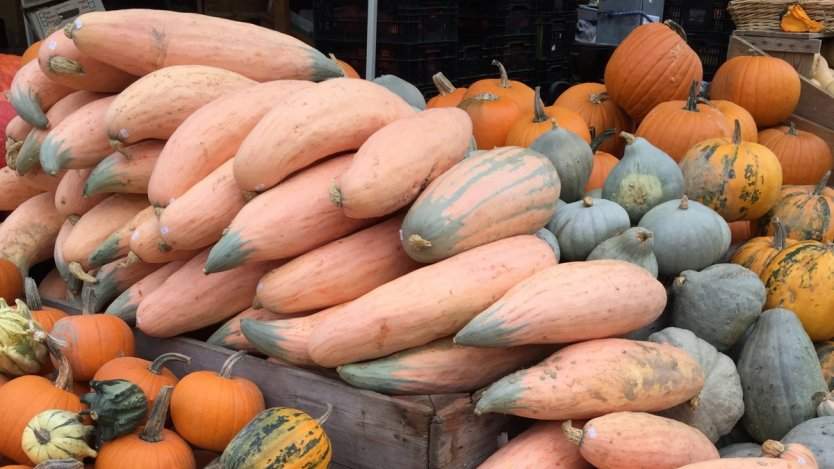After the squash of summer are gone (might make an OK song, right?), it’s time to give their winter counterparts some attention. Butternut and acorn are staples in the fall and winter pantry, but there are plenty of alternatives. Whether you roast, stuff, steam, or puree them, here’s the lowdown on some of the most common types of squash to incorporate into your repertoire.
Sugar pumpkins
Shame on you if you associate pumpkin pies with canned pumpkin! Making your own pumpkin puree is so simple, there’s really no excuse not to do it from scratch. Look for tiny sugar pumpkins, which are much sweeter and also less watery than those typically reserved for carving. Scoop out the seeds, roast, puree, cool, and you are ready for whatever pie-making adventures you want to set off on. Sugar pumpkins can also be used in savoury applications. Hollowed out, they make lovely soup bowls.
Butternut
Butternut squash is a mainstay. Its thin skin and sweet, nutty flesh make it perfect to peel, cube, and roast on the fly for an easy addition to any weeknight meal. Try dicing it up and tossing it into your go-to apple crisp recipe for an unexpected addition. The upside is that butternut squash is great at keeping its shape when it cooks, so you won’t end up with apples mixed with mysterious orange mush. No one wants that for dessert.
Kabocha
If you are looking for an aphrodisiac squash, kabocha could be it, or so they say. Maybe if they were paired with oysters and chocolate, but on their own, we’re not so sure. This Japanese variety has a dark green exterior and is superior to many with its sweet, almost honey-like flesh that is also dense and creamy. It holds up well when cooked, making it the perfect addition to hearty soups and stews, or atop a satisfying fall salad.
Acorn
Along with butternut, acorn squash is a staple at farmers’ markets and grocery stores everywhere come fall. It has a pretty subtle flavour (read: it doesn’t taste like much). Because of its mildness and size, it is the perfect squash to stuff to the brim with other flavourful goodies. Fill it with pre-cooked grains and mushrooms as a meatless entrée. Or, you can peel and cube them, then add them to stews. For a side dish, simply cut it in a half and roast it with plenty of butter and brown sugar in the cavity.
Delicata
Delicata is the ideal squash for the lazy cook because a) they are small and easy to cut/handle and b) the skin is totally edible, so no peeling necessary. On the flipside, they don’t store as long as their thick-skinned buddies, but they taste too good to last anyway. You can roast slices of delicata as is, and try not to burn your mouth from eating them straight from sheet tray as you pull them out of the oven; but they also make a great addition to pizza, salads, or sandwiches, along with plenty of other fall veg.
Red kuri
Tear-drop shaped red kuri squash, also referred to as Hokkaido squash, look kind of like tiny pumpkins and can definitely be used in a similar manner. Their nutty, sweet flesh makes a great puree for any kind of baking. Kuri squash pie? No problem. Kuri squash muffins? Breakfast is calling! If you really want to get into the fall spirit without giving up a favourite summer treat, try mixing the puree into a basic ice cream base and churning up a batch of kuri squash ice cream. Sandwich it between chewy ginger cookies and we’re talking autumn desserts!
Spaghetti
Spaghetti squash is all about the texture. When cooked, it can be easily shredded into spaghetti-like strands and used however you would typically use normal spaghetti, like dressing it with a bolognese sauce or other sauces. Spaghetti squash is also fun to stuff with other ingredients that bring more flavour to the party.
Hubbard
The green- to gray-skinned hubbard squash is the giant of the bunch, typically weighing between six to 20 pounds. Bigger isn’t always better, however; the larger they get, the more watery and bland they become. And who wants to lug home a 20-pound squash? Hubbards can sometimes be mealy so personally, I’d puree them and mix with butter, brown sugar, and cinnamon and call it a day. You can also roast them and toss them with herbs and butter for a savoury dish. Given that they can be stored for up to 5 or 6 months, you’ve got some time to think about what you’d like to do with them.
Buttercup
These sneaky little buggers disguise themselves as kabocha squash (although they tend to be more boxy shape and also have a distinctive bump on the bottom), and sorry to say, they’re not. Sure they taste similar, but they are not as sweet and also a bit more wet, so they tend to break down if you cook them for too long. Given their creamy texture though, they would make a great addition blended into hummus or any thick dip.













